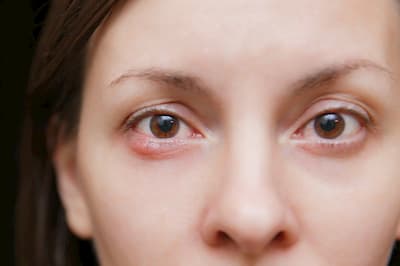Barley on the eye

Ophthalmologist, Laser Ophthalmosurgery
Arevik Karapetyan
Experience 6 year
Ophthalmologist
Acute purulent inflammation in the hair follicle of the eyelash or in the sebaceous gland is called "barley" because of its characteristic round shape, resembling a grain. The external harmlessness of this phenomenon is deceptive: it clearly indicates a decrease in the protective properties of the immune system and requires careful treatment to prevent relapses and possible complications.
Causes of the appearance of barley on the eye
Staphylococci, which prefer to settle on human skin and hair, do not manifest themselves in any way with strong immunity. Their intensive reproduction is triggered by a decrease in the protective properties of the body, its hypothermia, severe diseases and hypovitaminosis, the consequences of helminthic invasion. Penetrating into the structure of the hair follicle, streptococci cause inflammation and suppuration as a reaction to a pathogenic microorganism. This is the main cause of barley in the eye in patients of all ages. With an unbalanced diet, increased physical exertion or stressful situations, the disease can occur in the form of several or multiple suppurations on the eyelids or mucous membranes. Also, among the factors contributing to the appearance of barley on the eye - the habit of touching the eyelids with dirty hands, a large amount of dust indoors or outdoors.
The risk group for the likelihood of the appearance of barley includes:
- patients with reduced immunity;
- persons with diseases of the endocrine system;
- patients with gastrointestinal tract pathologies;
- persons whose professional activities involve working on the street or in rooms with difficult climatic or unsanitary conditions;
- patients who have suffered from inflammatory diseases of the eyes and eyelids, as well as those who have not completed the prescribed course of treatment.
Symptoms of barley on the eye

Suppuration of the eyelid makes itself felt with a feeling of heaviness, swelling and inflammation along the eyelash growth line. The area becomes painful, the temperature of the eyelid skin rises. The edema line has clear boundaries, signs of hyperemia - redness and inflammation are noticeable on the conjunctiva. Within 2-3 days from the moment of development of barley, a purulent head is formed on its surface, the contents of which are dead cells of the hair follicle.
With internal barley, the pathology is localized in the area under the eyelid - in the so-called meibomian gland, which makes the disease almost invisible. The inflammatory process is indicated by the characteristic symptoms of barley - compaction and soreness of the affected eyelid. The danger of such a disease is the development of chalazion - inflammation of the cartilage around the meibomian gland, which significantly delays the healing process and forces the patient to undergo regular examination by an ophthalmologist.
In severe cases, with barley localized inside the sebaceous gland, signs of general intoxication are observed - head and muscle pain, fever, swollen lymph nodes. Self-medication in this case is categorically contraindicated, and the patient should immediately seek medical help.
Species and stages of development of barley
Depending on localization and external signs, they are distinguished:
- external barley is a painful formation on the lash line that quickly suppurates. Signs of barley in this case are visible to the naked eye, which simplifies the diagnosis;
- internal barley - localized within the eyelid, causes inconvenience with severe pain and a feeling of a foreign object in the eye. It is found during a visual medical examination.
The formation and development of barley occurs in several stages:
- infiltration process. The appearance of the first characteristic signs of suppuration is noted: itching, swelling, redness of the eyelid in the area of inflammation. Within a few hours, the discomfort intensifies;
- suppuration process. A capsule with purulent contents is visible on the surface of the formation. With an increase in the volume of pus or mechanical stress, it may break out prematurely;
- the process of breaking through a purulent capsule. If the inflammation does not break out on its own, the surgeon will open it. The separation of purulent contents occurs within several days;
- healing. A crust forms at the site of the ulcer, under which a thin layer of regenerated skin forms. Depending on the quality of the course of treatment and the state of the immune system, the healing period can take from several days to several weeks.
Complications of barley on the eye

The importance of seeking medical attention when barley appears due to the high risk of developing the following complications:
- conjunctivitis - an infectious lesion of the mucous membrane of the eye, causing swelling, hyperemia and some deterioration in vision. Treatment of the disease is complex and lengthy;
- chalazion - formation of a cystic nature on the inside of the eyelid. Causes inconvenience, requires long-term treatment;
- phlegmon of the orbit - caused by profuse suppuration due to an attempt to independently open barley or multiple formation of foci of suppuration with their subsequent fusion. Symptoms of this pathology are visual impairment, severe puffiness, discomfort when moving the eyelid, etc.;
- thrombosis of the plexus of blood vessels is a violation of the outflow of fluid from the orbit, which causes swelling. The eyeball bulges out, the skin turns blue, the eyelids become inflamed, and vision deteriorates sharply;
- thrombophlebitis is an inflammatory process in the blood vessels. It is characterized by headache, feeling of fatigue, decreased visual acuity, redness of the mucous membrane of the eye;
- meningitis - the consequences of eye phlegmon. Signs of a deadly pathology: temperature above 39 ° C and severe headache;
- sepsis - blood poisoning due to the ingress of pus and pathogenic microorganisms into it. Signs of complications: intoxication of the body, chills, heart palpitations, rash, respiratory failure.
Diagnostics of barley
Making the correct diagnosis is possible already with an external examination of the patient and the analysis of his complaints. If the disease occurs relatively often, laboratory tests will be required to exclude or identify:
- diabetes mellitus;
- helminthic invasions;
- HIV / AIDS or other diseases that cause a sharp decrease in immunity.
Treatment of barley

With strong immunity, the disease can go away on its own without special treatment. This happens if the adverse effect on the body has ceased, and the activation of staphylococcus was suppressed.
Self-treatment of barley on the eye with medicines at home is not recommended. Moreover, folk recipes often pose a threat to vision. Tips on how to treat barley can rupture the purulent capsule and infect the mucous membrane of the eye with the most serious consequences.
A course prescribed by a specialist will be many times more effective and safer. Its components are antibacterial drugs, local antibiotic agents and compounds for relieving the inflammatory process. Treatment of barley should be carried out under the supervision and on the basis of the recommendations of a specialist. If a complication develops, he will immediately adjust the course and take measures to prevent further inflammation.
Prevention of barley
To eliminate the risk of the appearance of barley will help:
- compliance with the rules of personal hygiene;
- measures to strengthen the body's defenses and restore immunity;
- exclusion of situations of overheating or hypothermia of the body;
- timely treatment of serious infectious diseases;
- active lifestyle;
- balanced nutrition, taking vitamin courses.
Additional recommendations, taking into account the state of the patient's body, will be given by the attending physician.
Questions and Answers
What causes barley on the eye?
The main cause of inflammation is infection of the sebaceous gland or hair follicle of the eyelash due to the active vital activity of staphylococci. This is facilitated by ambient air pollution, a decrease in the protective properties of the immune system, and non-compliance with personal hygiene rules. Less commonly, barley appears on the eye due to difficult conditions of professional activity or untreated infectious eye diseases.
How does barley appear?
The first signs of barley manifestation are eyelid discomfort, noticeable inflammation and swelling of the eyelash area, itching and a feeling of some heaviness. Within a few days, a yellow purulent head of the inflammation focus becomes visible on the surface of the skin. As it matures, it breaks through, after which a number of "inflammatory" symptoms of the disease go away, but a slight itching and area of redness remains.
How to quickly remove barley from the eye?
Any treatment for barley should be agreed with an ophthalmologist without fail. The sooner you seek help, the faster you will be able to cope with the pathology. Antibacterial agents and topical ointments will help speed up the breakthrough of the purulent capsule. Attempts to quickly remove barley from the eye with compresses, warming or squeezing out pus are very dangerous and can cause serious inflammation of the mucous membrane and damage to the eyeball.




